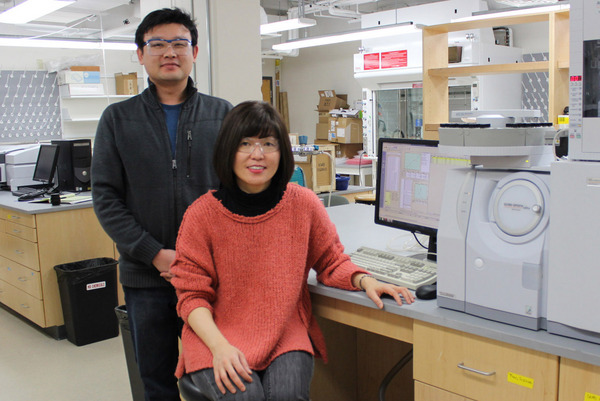In a study published March 9 in Nature Chemistry, University of Wisconsin-Madison chemistry Professor Kyoung-Shin Choi presents a new approach to combine solar energy conversion and biomass conversion, two important research areas for renewable energy.
For decades, scientists have been working to harness the energy from sunlight to drive chemical reactions to form fuels such as hydrogen, which provide a way to store solar energy for future use.
Toward this end, many researchers have been working to develop functional, efficient and economical methods to split water into hydrogen, a clean fuel, and oxygen using photoelectrochemical solar cells (PECs).
Top Image: Chemistry Professor Kyoung-Shin Choi (right) and postdoctoral researcher Hyun Gil Cha (left) have developed an innovative approach to combining solar energy conversion and biomass conversion. Image Credit: UW-Madison Chemistry Department
Although splitting water using an electrochemical cell requires an electrical energy input, a PEC can harness solar energy to drive the water-splitting reaction. A PEC requires a significantly reduced electrical energy input or no electrical energy at all.
In a typical hydrogen-producing PEC, water reduction at the cathode (producing hydrogen) is accompanied by water oxidation at the anode (producing oxygen). Although the purpose of the cell is not the production of oxygen, the anode reaction is necessary to complete the circuit. Unfortunately, the rate of the water oxidation reaction is very slow, which limits the rate of the overall reaction and the efficiency of the solar-to-hydrogen conversion. Therefore, researchers are currently working to develop more efficient catalysts to facilitate the anode reaction.
Choi, along with postdoctoral researcher Hyun Gil Cha, chose to take a completely new approach to solve this problem. They developed a novel PEC setup with a new anode reaction. This anode reaction requires less energy and is faster than water oxidation while producing an industrially important chemical product. The anode reaction they employed in their study is the oxidation of 5-hydroxymethylfurfural (HMF) to 2,5-furandicarboxylic acid (FDCA). HMF is a key intermediate in biomass conversion that can be derived from cellulose — a type of cheap and abundant plant matter. FDCA is an important molecule for the production of polymers.
Biomass conversion can offer a viable pathway to generate chemicals used in industrial processes without using petroleum products. Conventional biomass conversion processes use high-pressure oxygen for the conversion of HMF to FDCA at high temperatures. Choi and Cha, however, developed an efficient electrochemical method to oxidize HMF to FDCA at room temperature and ambient pressure using water as the oxygen source. Then they employed this oxidation reaction as the anode reaction of the PEC that produces hydrogen at the cathode. By doing so, they demonstrated the utility of solar energy for biomass conversion as well as the feasibility of using an oxidative biomass conversion reaction as an anode reaction in a hydrogen-forming PEC.
“Since the photoelectrochemical cell is built for the purpose of hydrogen production and HMF oxidation simply replaces oxygen production at the anode, in essence, no resources are used specifically for HMF oxidation,” says Choi.
In other words, FDCA is a bonus byproduct from a PEC that generates hydrogen. The production of FDCA, a valuable chemical, at the anode lowers the production cost for hydrogen. This new approach therefore presents new possibilities for research in both solar conversion and biomass conversion.
“When we first started this study, we were not sure whether our approach could be really feasible,” Choi says. “However, since we knew that the impact of the study could be high when successful, we decided to invest our time and effort on this new research project at the interface of biomass conversion and solar energy conversion.”
Developing and optimizing every piece of the full solar cell setup demonstrated in the study took the researchers about two years. Choi expects that the development of more diverse and efficient electrochemical and solar-driven biomass conversion processes will increase the efficiency and utility of solar-fuel-producing PECs.
References:
Publication: Hyun Gil Cha, Kyoung-Shin Choi. Combined biomass valorization and hydrogen production in a photoelectrochemical cell. Nature Chemistry, 2015
Story: Researchers develop new approach that combines biomass conversion, solar energy conversion | University of Wisconsin-Madison — March 10, 2015












Comments